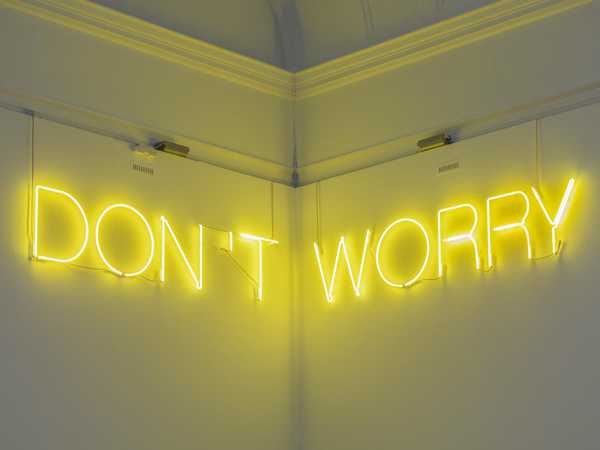Untitled
1988 - Installation (Installation)
39 3/8 x 31 1/8 in.
Martin Kippenberger
Martin Kippenberger’s late collages are known for incorporating a wide range of materials, from polaroids and magazine clips to hotel stationery, decals, and graphite drawings. Untitled is a collage on paper work by Kippenberger that typifies his everything-goes approach: a barely discernible, sliced image of Michael Jackson’s face is overlaid and woven with strips and triangular shapes from a different source into a single composition. Blue tones come from torn out pages of a book where fragments of illustrations can be seen. Together, all the elements suggest an alternative, highly stylized portrait of the artist; in this case, a fragmented, fluid, and itinerant sense of identity. Consistent with other works by the artist, Untitled defies any specific style and continues Kippenberger’s inquiry into the self and its potential to manifest through the objects and materials that we modify.
Martin Kippenberger is widely regarded as one of the most talented German artists of his generation. Although he was incredibly prolific in a diverse range of media—drawings, collage, sculpture, performance, painting, photography, installations, prints, ephemera.—his best-known works are paintings, many of them self-portraits. Kippenberger was a very polarizing figure, known by many for being a provocateur and for making politically charged work as artworld commentary. Often taking on different art historical tropes, his work tested the boundaries of authorship and originality. He was known to hire others to paint for him under a pseudonym, or use work by other artists to create new work. Examples include restaging a photograph of Pablo Picasso; turning a monochrome by Gerard Richter into a coffee table; and claiming an installation of his as the last chapter of an unfinished novel by Franz Kafka. One of his key concerns was to try to understand the artist’s place in the modern world, and how their essence and personality can become apparent in the objects that they create.
Colors:
Related works of genres: » contemporary artist, » conceptual artist, » german contemporary artists, » 1953–1997, » installation artist, » artist's book, » relational art

© » KADIST
Hans-Peter Feldmann
The types of objects Feldmann is interested in collecting into serial photographic grids or artist’s books are often also found in three dimensional installations...

© » KADIST
Hans-Peter Feldmann
The types of objects Feldmann is interested in collecting into serial photographic grids or artist’s books are often also found in three dimensional installations...

© » KADIST
Hank Willis Thomas
2012Like many of his other sculptural works, the source of I am the Greatest is actually a historical photograph of an identical button pin from the 1960s...

© » KADIST
Rodney Graham
1991Ponderosa Pine IV belongs to a series of large-scale photographs of trees taken by Graham and depicts a particular species that live in Northern California...

© » TATE EXHIBITIONS
Martin Creed
Martin Creed | The Dick Institute Experience the work of one of this country’s most ingenious, audacious and surprising artists at the Dick Institute ARTIST ROOMS Martin Creed presents highlights from the British artist’s thirty-year career...

© » KADIST
Hank Willis Thomas
2013The image is borrowed from protests during Civil Rights where African Americans in the south would carry signs with the same message to assert their rights against segregation and racism...

© » KADIST
Hank Willis Thomas
2012Intentionally Left Blanc alludes to the technical process of its own (non)production; a procedure known as retro-reflective screen printing in which the image is only fully brought to life through its exposure to flash lighting...

© » KADIST
Francis Alÿs
2004The Nightwatch , which is an ironic reference to the celebrated painting by Rembrandt, follows the course of a fox wandering among the celebrated collections of the National Portrait Gallery in London...

© » KADIST
Ulla von Brandenburg
2007Eight opens with a close up of a painting by Hubert Robert of the Chateau de Chamarande where the film was shot...

© » KADIST
Gabriel Orozco
2002Gabriel Orozco comments: “In the exhibition [Documenta 11, Kassel, 2002], I tried to connect with the photographs I took in Mali in July...

© » KADIST
Raymond Pettibon
2007The five works included in the Kadist Collection are representative of Pettibon’s complex drawings which are much more narrative than comics or cartoon...

© » KADIST
Laure Prouvost
2018Monteverdi Ici – Deeply, Feeling Filling the World by Laure Prouvost is a tapestry that references a video by the artist entitled Monteverdi Ici (2018)...

© » KADIST
Kara Walker
2005In her masterpiece 8 Possible Beginnings or The Creation of African-America , Walker unravels just that, the story of struggle, oppression, escape and the complexities of power dynamics in the history following slave trade in America...

© » KADIST
Raymond Pettibon
2006The five works included in the Kadist Collection are representative of Pettibon’s complex drawings which are much more narrative than comics or cartoon...

© » KADIST
Raymond Pettibon
2000Untitled (Wall Street’s Chosen Few…) is typical of Pettibon’s drawings in which fragments of text and image are united, but yet gaps remain in their signification...

© » KADIST
Hank Willis Thomas
2012Bread and Roses takes its name from a phrase famously used on picket signs and immortalized by the poet James Oppenheim in 1911...

© » KADIST
Hans-Peter Feldmann
The types of objects Feldmann is interested in collecting into serial photographic grids or artist’s books are often also found in three dimensional installations...



